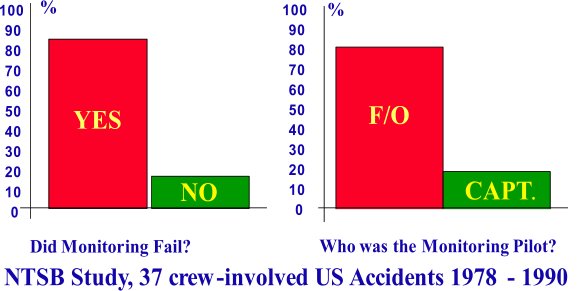NTSB Study SS-94/01
In 1994 the NTSB made a major detailed study of crew errors in some 37 US airline accidents. The safety issues discussed included the performance of flightcrews when the captain is the flying pilot and the first officer is the non-flying pilot, and the performance of the non-flying pilot in monitoring and challenging errors made by the flying pilot. Other aspects addressed included checklist procedures, associations between flightcrew performance and crewmember experience, crewmembers' familiarity with each other, work/rest issues, flight delays, and CRM training.
The study recognised that a common factor in accidents was a tactical error by the Pilot Flying that had not been effectively challenged by the PNF, and that this was disproportionately far more common when the Captain was the PF. It also referred to NASA's 1979 full mission simulations, which documented that sound decision-making is more difficult for the Captain when he also acting as PF.
In discussing tactical errors, the 1994 study noted that when a course of action needs to be modified, "a captain/flying pilot must first perceive a need to change, then must alter his or her own current plan and behavior. The decision to change a course of action may be inhibited by overconfidence in ability or the earlier decision to engage in the ongoing course of action. These dynamics probably were relevant in eight accidents involving a failure to execute a go-around during unstabilised approaches."

The study continued, "The tactical decision/errors of omission may be particularly difficult to catch, especially for first officers. In monitoring and challenging a captain's tactical decision error, a first officer may have difficulty both in deciding that the captain has made a faulty decision, and in choosing the correct time to question the decision. A first officer may be concerned that a challenge to a decision may be perceived as a direct challenge to the captain's authority.
For example, challenging a captain's failure to execute a go-around may be much more difficult for a first officer to do, in a timely fashion, than challenging a straightforward procedural error whose correction is unarguable, such as failure to turn on a transponder prior to takeoff.
The absence of action (error of omission) may not call attention to itself as an error as readily as an error of commission. Also, in many situations there may be a period of seconds or minutes when action could be taken. Thus, there may be no distinct signal or cue that now is the time to speak up about another crewmember's failure to act, and a challenge may be deferred in hope that the error will be corrected soon."
A 2010 NASA study (Dismukes and Berman) points out the continuation of this problem. Its discussion of "deviation trapping" notes that "Captains in the monitoring pilot role were more than twice as likely to trap deviations made by the flying pilot than first officers in the monitoring pilot role (27.9% vs. 12.1%). This is consistent with [other quoted] flight simulation research showing that captains were more likely to challenge first officers flying the aircraft than vice versa".
Although these studies do not specifically use the phrase, this is what is now commonly called the "cross-cockpit authority gradient". The NTSB made extensive and detailed recommendations about training the need for extensive Crew Resource Management training to overcome these problems which it clearly considered to be one of the most fundamental issues affecting airline safety.